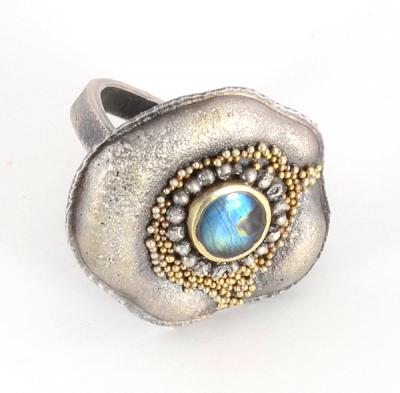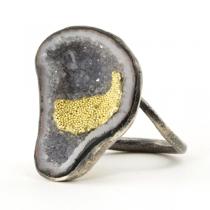
Susan Cummins: Harold, you are known for your technical expertise. In fact, you conduct classes all around the world teaching embossing, granulation, and reticulation, among other things. Did learning these skills come easily to you? Can you tell the story of the way you acquired them?
Harold O’Connor: I first learned granulation at school in Pforzheim, Germany, in 1967, but I had forgotten that I had already learned it, as my portfolio of early works I showed at Martha Connell Gallery in Atlanta demonstrates. In 1988 I went to a small workshop in the town of Ahlen, in northern Germany, called the European Gold and Silversmith Academy, to learn granulation in gold. There I met several participants from Cologne, Germany. Eventually they became best friends and also introduced me to other masters of the technique in Cologne. By visiting their workshops, I was able to pick up more hints on executing the technique. We saw the works of Germany’s most famous granulationist, Elizabeth Treskow from Cologne (who has a street and a square named after her). The American granulationist John Paul Miller met with Treskow when he was in Europe. Most likely he, too, picked up some pointers from her. After learning granulation, I did not do it at all for one and a half years, as I did not care to make the classical patterns, such as triangles and pyramids of beads. One day in the studio I realized that the 18-karat gold granulation would go well with reticulated silver patterns. From that beginning I have created many forms over the years in this combination. I had been doing some reticulation on sterling silver over the early years but the results were lacking in pattern and detail. Somewhere along the way I broke down and bought some reticulation silver (.820 silver) and a whole new world opened for me in creating forms with interest and dimension. The granulation evolved over time and in recent years I have added the use of silver granulation in combination with the gold. I tell people that doing granulation is like working with enamels—one needs patience and time and a steady hand. Time is consumed in making the beads for granulation, done by heating small snips by hand or in a kiln. The most difficult process to learn is knowing the right temperature at which the beads fuse to the metal surface. Twenty years into it, I’m still learning what works and what doesn’t. Granulation for me is like Zen meditation.

Susan Cummins: Harold, you are known for your technical expertise. In fact, you conduct classes all around the world teaching embossing, granulation, and reticulation, among other things. Did learning these skills come easily to you? Can you tell the story of the way you acquired them?
Harold O’Connor: I first learned granulation at school in Pforzheim, Germany, in 1967, but I had forgotten that I had already learned it, as my portfolio of early works I showed at Martha Connell Gallery in Atlanta demonstrates. In 1988 I went to a small workshop in the town of Ahlen, in northern Germany, called the European Gold and Silversmith Academy, to learn granulation in gold. There I met several participants from Cologne, Germany. Eventually they became best friends and also introduced me to other masters of the technique in Cologne. By visiting their workshops, I was able to pick up more hints on executing the technique. We saw the works of Germany’s most famous granulationist, Elizabeth Treskow from Cologne (who has a street and a square named after her). The American granulationist John Paul Miller met with Treskow when he was in Europe. Most likely he, too, picked up some pointers from her. After learning granulation, I did not do it at all for one and a half years, as I did not care to make the classical patterns, such as triangles and pyramids of beads. One day in the studio I realized that the 18-karat gold granulation would go well with reticulated silver patterns. From that beginning I have created many forms over the years in this combination. I had been doing some reticulation on sterling silver over the early years but the results were lacking in pattern and detail. Somewhere along the way I broke down and bought some reticulation silver (.820 silver) and a whole new world opened for me in creating forms with interest and dimension. The granulation evolved over time and in recent years I have added the use of silver granulation in combination with the gold. I tell people that doing granulation is like working with enamels—one needs patience and time and a steady hand. Time is consumed in making the beads for granulation, done by heating small snips by hand or in a kiln. The most difficult process to learn is knowing the right temperature at which the beads fuse to the metal surface. Twenty years into it, I’m still learning what works and what doesn’t. Granulation for me is like Zen meditation.

Harold O’Connor: My favorite materials to work with at this point in my life are still natural ones like wood, bone, metals, and some amber. In the early 70s I worked with plastic resins, and then photo etching in the late 70s. I also used titanium when it was a “new material.” I liked to color titanium but didn’t care for the hardness of its workability aspects. The dominant material for me is always metal—it has just so many endless possibilities.
Where did you learn the kind of forms you use in your jewelry? They are multiple and varied, but recognizably yours. How would you describe them?
Harold O’Connor: When I came out of school in Germany in 1967, I was doing a lot of fused metal (without solder) in gold. I learned design from one of the leading German professors at the school, Professor Reinhold Reiling. The work was “organic” in nature and looked like it was cast, but was constructed. Over the years I have worked on many “themes” of work, which all took on an individual look of their own. While teaching at the Alberta College of Art in Calgary, Alberta, Canada, I worked on organic forms created from heating polyurethane porous plastic to create highly textured surfaces—these were then cast into jewelry forms.
In the summer of 1972 I had the opportunity to attend the International Summer Academy of Fine Arts in Salzburg, Austria, for a jewelry class. I didn’t make anything due to emotional turmoil, but the experience changed my life and work. Up until that class I was just making “things” with no content. As a result of that summer in Austria, I came home and rethought the forms I was creating and looked at my works in a different way.
Other themes I have worked on are replicating old mining machines in the scale of an inch and a half (I call them photorealism). Some of the other themes I have worked on are items in a Japanese garden (the one in Denver is a favorite spot) and a series called Timeless Watches: How Society Thinks of Time. One series of work was inspired by the movie Incredible Journey, where the characters are injected into the blood stream of a human, and another by How to Wrap Five Eggs, an exhibition of Japanese packaging;
I don’t look much at contemporary jewelry but take my inspiration from sculptors like David Smith, Noguchi, and Caro. I say I make little objects that people can wear.

Since you have spent time traveling around the world, I wonder if you have a favorite culture where you think the jewelry is fantastic?
Harold O’Connor: Through my travels I find that the most outstanding jewelry is coming out of Estonia. This small Baltic country has a long history of handwork and fine art and a long history of storytelling and mythology. Estonian jewelry today is some of the most original being created anywhere.

Harold O’Connor: The role of jewelry can be many things in culture. It can be ritual, adornment, political, indicate status, or just for fun.
Who are your favorite artists now?
Harold O’Connor: My favorite jewelry artists today are: the Americans Jim Cotter, Kent Raible, and Jeff and Susan Wise; Kristiina Laurits and Kadri Mälk in Estonia; Jaroslav Kodejs in the Czech Republic; Giovanni Corvaja, Giampaolo Babetto, Annamaria Zanella, and Stefano Marchetti in Italy; Ramon Puig Cuyàs in Spain; Ruudt Peters in Holland; Karl Fritsch and Wilhelm Mattar of Germany; Charles Lewton-Brain in Canada; and Filomeno Pereira de Sousa of Portugal.
What have you seen, heard, or read that you would like to recommend?
Harold O’Connor: Of the galleries for contemporary jewelry, I would say that if you only had one place to go, it would be Galerie Marzee in Nijmegen, Holland—the largest overview of jewelry artworks in Europe, both of established and emerging artists. Best-kept secret is the silver festival in Legnica, Poland, during May—many exhibitions and an annual international competition.
Thank you.




